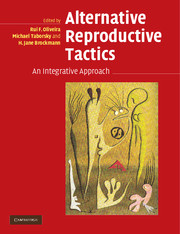Book contents
- Frontmatter
- Contents
- List of contributors
- Preface
- 1 The evolution of alternative reproductive tactics: concepts and questions
- PART I ULTIMATE CAUSES AND ORIGINS OF ALTERNATIVE REPRODUCTIVE TACTICS
- PART II PROXIMATE MECHANISMS OF ALTERNATIVE REPRODUCTIVE TACTICS
- PART III TAXONOMIC REVIEWS OF ALTERNATIVE REPRODUCTIVE TACTICS
- PART IV EMERGING PERSPECTIVES ON ALTERNATIVE REPRODUCTIVE TACTICS
- 16 Communication and the evolution of alternative reproductive tactics
- 17 Alternative mating tactics and mate choice for good genes or good care
- 18 Conflict between the sexes and alternative reproductive tactics within a sex
- 19 Cooperative breeding as an alternative reproductive tactic
- 20 Integrating mechanisms and function: prospects for future research
- Index of species
- Subject index
- References
16 - Communication and the evolution of alternative reproductive tactics
Published online by Cambridge University Press: 10 August 2009
- Frontmatter
- Contents
- List of contributors
- Preface
- 1 The evolution of alternative reproductive tactics: concepts and questions
- PART I ULTIMATE CAUSES AND ORIGINS OF ALTERNATIVE REPRODUCTIVE TACTICS
- PART II PROXIMATE MECHANISMS OF ALTERNATIVE REPRODUCTIVE TACTICS
- PART III TAXONOMIC REVIEWS OF ALTERNATIVE REPRODUCTIVE TACTICS
- PART IV EMERGING PERSPECTIVES ON ALTERNATIVE REPRODUCTIVE TACTICS
- 16 Communication and the evolution of alternative reproductive tactics
- 17 Alternative mating tactics and mate choice for good genes or good care
- 18 Conflict between the sexes and alternative reproductive tactics within a sex
- 19 Cooperative breeding as an alternative reproductive tactic
- 20 Integrating mechanisms and function: prospects for future research
- Index of species
- Subject index
- References
Summary
CHAPTER SUMMARY
In this chapter, concepts derived from communication network theory are applied to the understanding of the evolution of signals in species with alternative reproductive tactics (ARTs). These species are particularly interesting to consider from the perspective of communicating in a network because the signaling and receiving behavior of different reproductive phenotypes can be expected to be subject to diverse selection pressures. We begin by briefly introducing ARTs and communication networks. Then the consequences of communicating in a network are considered from the perspective of the several reproductive phenotypes occurring in species with ARTs, both as signalers and receivers. Finally, the evolutionary outcome of conflict and cooperation between these reproductive phenotypes is predicted in an integrative approach, and new directions are proposed to test some of the hypotheses derived.
INTRODUCTION
Alternative reproductive tactics (ARTs) is the term used to refer to variation in mating behavior found within a species. As the topic is the subject of this book, we will only briefly introduce ARTs in relation to signaling. More detailed information on ARTs can be found in several chapters in this book and recent reviews (e.g., Brockmann 2001, Shuster and Wade 2003).
For simplicity, we have only considered male ARTs. This choice reflects the facts that male ARTs are more common than female ARTs (but see Alonzo, Chapter 18, this volume) and that many more examples of male ARTs have been described. Nevertheless, the ideas presented here extend directly to female ARTs.
- Type
- Chapter
- Information
- Alternative Reproductive TacticsAn Integrative Approach, pp. 401 - 420Publisher: Cambridge University PressPrint publication year: 2008



